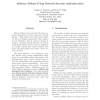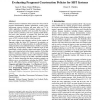86 search results - page 17 / 18 » Learning attack strategies from intrusion alerts |
IWIA
2005
IEEE
13 years 10 months ago
2005
IEEE
Malware defenses have primarily relied upon intrusion fingerprints to detect suspicious network behavior. While effective for discovering computers that are already compromised,...
VEE
2006
ACM
13 years 11 months ago
2006
ACM
Software Dynamic Translation (SDT) systems have been used for program instrumentation, dynamic optimization, security policy enforcement, intrusion detection, and many other uses....
KDD
2004
ACM
14 years 5 months ago
2004
ACM
Essentially all data mining algorithms assume that the datagenerating process is independent of the data miner's activities. However, in many domains, including spam detectio...
SP
2006
IEEE
13 years 11 months ago
2006
IEEE
Attackers and defenders of computer systems both strive to gain complete control over the system. To maximize their control, both attackers and defenders have migrated to low-leve...
SP
1989
IEEE
13 years 9 months ago
1989
IEEE
In early November 1988 the Internet, a collection of networks consisting of 60,000 host computers implementing the TCP/IP protocol suite, was attacked by a virus, a programwhich b...


